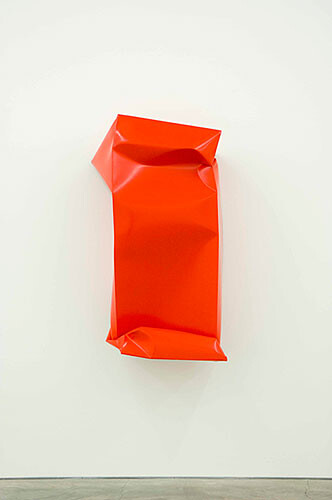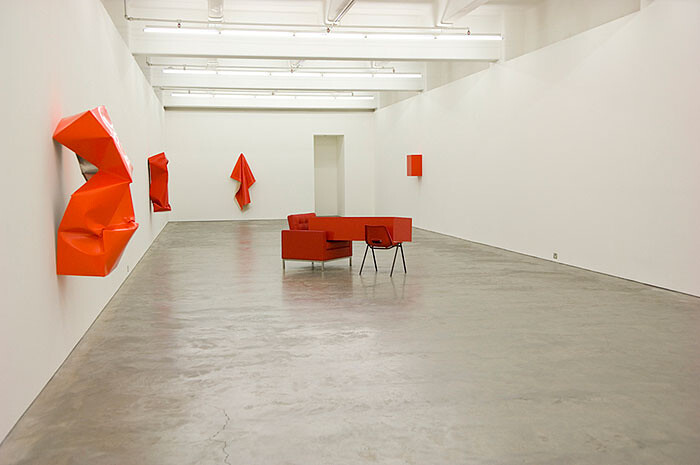Every article one reads on de la Cruz’s work will begin with a character analysis of the firey Spaniard who gave birth to a child despite spending months of the pregnancy in a stroke-induced coma. This kind of mythologizing inevitably foregrounds the artist as the subject of her own work. And though her work has followed a similar trajectory since she first removed a canvas from its stretcher while studying at the Slade in the nineties—now especially, with de la Cruz being wheelchair-bound, the relationship between her persona and her artwork have become interlinked.
De la Cruz’s latest exhibition “Transfer” at Anna Schwartz Gallery plays up this relationship explicitly with the press release referring to the works as “anthropomorphic” and asserting that the exhibition “forcefully foregrounds the body, both artist’s and viewers’.” Typically, with contemporary art the relationship between the artist and their work requires entire weaves from Ariadne’s skein to navigate our way through the labyrinths of reference and innuendo, however, with this exhibition there is an immediacy of access that is at once refreshingly direct and also problematic.
Featuring an elegantly installed collection of works typical of de la Cruz’s practice, “Transfer” offers an important sampling of this ex-Turner Prize nominee’s current work. Seven paintings and sculptures evenly pace the exhibition’s rhythm. There are two of de la Cruz’s trademark unstretched canvases, Extension 3 (Red/Orange) (2011) and Deflated 21 (Red) (2011), which, when absolved from their reliance on a frame, reflect on space rather than surface. This is then reiterated by the deceptive materiality of two large sculptural works, Compressed (Orange) and Compressed (Red) (both 2011). Constructed from aluminium, these one-and-a-half-meter high oblongs are monochromes with the surface of each compressed or indented, resulting in a cardboard-like crumpling.
All of the works in this exhibition have been constructed so that their proportions emulate those of the human body, with Compressed (Orange) and Compressed (Red) scaled specifically to match the artist’s body. Likewise, the title work Transfer (2011) features a similarly proportioned rectangular box (though this time constructed from wood) with the “feet” of the sculpture propped on a seat, whilst the other end “sits” on a modernist Florence Knoll arm chair. This further reiterates the sculpture’s undeniable anthropomorphism, presenting a reclining nude of broken, simplified forms.
Despite the rarity of such overt chronicling of the self in contemporary practice, this exhibition repeatedly affirms the biographical nature of these works. Scratch 1 (Red) (2011), for example, features a red painted aluminium square traversed with horizontal scratches, which were inflicted by the artist’s wheelchair running over the paintings—the physical imprint of the artist’s altered body laid bare.
Physically colliding the body with the forms of geometric modernism in this way opens up the possibility for discussion about subjectivity and modernism; however, the continued return to the biographical seems all the more simplistic, even clichéd and in some ways short circuits a more theoretical reading of these objects. “Transfer” employs two colors —a red and an orange—across the entire exhibition, and the artist explained that she wanted them to be “like blood.” It is difficult to believe that the personal can still be (so simply) political. Furthermore, de la Cruz’s reluctance to explain her work from a feminist perspective prohibits the possibility of reading these works as a critical reinterpretation of the inherently masculine modernist tropes.
But somehow, despite and perhaps because of the disconcerting extimacy of these works, this is what they manage to do. Approaching Compressed (Orange) and Compressed (Red), which are more than a little reminiscent of Tony Smith’s or Richard Serra’s sculptural works, one is taken aback by the brutality of their crushing. The indented surface seems to have been caused by a violent embrace or a kinetic closeness that runs counter to the staid formality of Smith’s or Serra’s imposing monumental gestures. In these works, de la Cruz manages to collapse the dominance of these twentieth century behemoths. Refusing any Greenbergian surfacing, the “form” is rendered formless—unreliable and yielding, deflating the certainty of modernism’s proclamations and infusing them with a more brutal and defiantly human presence.






